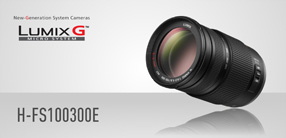We’re pleased to announce three new interchangeable lenses based on the Micro Four Thirds System standard.
These innovative new LUMIX G Micro System lenses include the world’s first interchangeable 3D lens1, the world’s lightest2 interchangeable single focal length lens, and an ultra-telephoto zoom lens. All three lenses realise high optical performance and compact size and offer many technical advantages. They bring the total number of LUMIX G Micro System lenses to 11.
The Single Focal Length Lens
LUMIX G 14mm / F2.5 ASPH (H-H014)
The world’s lightest interchangeable single focal length lens, the LUMIX G 14 mm / F2.5 ASPH. features a 14mm (35 mm camera equivalent: 28 mm) wide angle and F2.5 brightness with sharp, high contrast image rendering. Taking advantage of the wide angle of view and deep depth of field, the compact LUMIX G 14 mm / F2.5 ASPH. offers excellent performance in shooting not only landscapes but also indoors.
Comprising six lenses in five groups including three aspherical lenses, the lens system achieves both compact size with a short overall length of 20.5mm and high optical performance. It also excels in shooting subjects with straight lines such as architecture, thanks to the minimised distortion. The integration of a stepping motor and inner focus drive system facilitates the use of silent, high speed contrast AF.
Seven blades give the aperture a rounded shape that produces an attractively smooth effect in out-of-focus areas when shooting at larger aperture settings. The highly reliable metal mount ensures durability for active use, and uses multi-coated lens elements that minimise ghosts and flare to further enhance shooting performance.
The Telephoto Zoom Lens
LUMIX G VARIO 100-300mm / F4.0-5.6 / MEGA O.I.S. (H-FS100300)
The new telephoto zoom lens LUMIX G VARIO 100-300mm / F4.0-5.6 / MEGA O.I.S. achieves 300mm (35 mm camera equivalent: 600 mm) handheld ultra-telephoto zoom shots, and has an astonishingly compact and lightweight profile.
The LUMIX G VARIO 100-300mm / F4.0-5.6 / MEGA O.I.S. allows photographers to capture distant subjects such as sports events, wild animals and aircraft – without carrying a huge conventional ultra-telephoto zoom lens and a heavy tripod with a high compression effect. Panasonic’s MEGA O.I.S. (Optical Image Stabiliser) powerfully compensates for hand shake to suppress blur in zoom shots.
The lens unit has 17 elements in 12 groups including an ED lens. By adopting the ED lens in the first lens group, chromatic aberration is effectively suppressed to render sharp, high contrast images with stable optical performance over the entire zoom range. The integration of a stepping motor with exclusive zoom tracking control system and inner focus drive system allows the use of accurate and high speed contrast AF, while still maintaining quiet operation.
Seven blades give the aperture a rounded shape that produces an attractively smooth effect in out-of-focus areas when shooting at larger aperture settings. The highly reliable metal mount assures durability for active use, and uses multi-coated lens elements that minimise ghosts and flare to further enhance shooting performance.
The 3D Lens
LUMIX G 12.5mm / F12 (H-FT012)
The world’s first interchangeable 3D lens – the LUMIX G 12.5mm / F12 (H-FT012) realises 3D still image shooting (35 mm camera equivalent: 65 mm3)4. It features two optical systems installed within the diameter of the lens mount, creating stereo images from the left and right lenses, to be processed with a 3D image processing system. Despite its unique performance, the 3D lens is extremely compact thanks to Panasonic’s advanced optical technologies and image processing system as well as structural design.
Shooting 3D content with an interchangeable lens system camera was previously possible by using panorama systems or a combination of two lenses and two CCDs, but these systems have drawbacks including the need for a dedicated 3D camera and the difficulties capturing moving objects. However, this new compact 3D-capable interchangeable lens allows easier handling and instant 3D shooting with cameras without a special structure for 3D shooting.
It produces 3D images without distortion or time lag between left and right images, even for moving objects. The 3D images, even close-up shots, taken with this lens offer enjoyable viewing on 3D televisions such
as the Panasonic VIERA 3D TV range.
This year, Panasonic has launched 3D VIERA TVs and a 3D Blu-ray Disc™ player, as well as a 3D consumer camcorder. As well as viewing 3D content, such as movies and sports, there are many consumers who want to enjoy 3D shooting themselves. This lens allows users to shoot landscapes, people, and a variety of subjects in high-quality 3D, to be enjoyed later on their 3D VIERA televisions at home. As 3D content becomes ever more popular across a variety of media, Panasonic is leading the industry in allowing consumers to create their own true-to-life 3D experience, using the LUMIX G Micro System.
Australian availability and pricing for all the lenses will be announced later in 2010.
To see the Full LUMIX G-Series range click here
For more posts on LUMIX Cameras please check here




Can the 3D lens be used on a GF1? I’ve seen various notes about firmware for the new G2 to handle it – what about older G series bodies? All the press releases seem to indicate the new for Panasonic software and hardware to view the images, but it still just creates two side by side images on the sensor, correct? i.e. totally usable but obviously not 3D until viewed by some special mechanism?
Brad Calkins
Hi Brad,
It will be possible to use the 3D lens with both the GH2 and with the G2 via a firmware upgrade. The lens is not compatible with the GF1. 3D images can be played back by connecting your 3D compatible G-Series camera to a 3D television by mini HDMI cable. The image played back on the cameras LCD screen will be 2D image . A firmware upgrade has been released to convert the software package supplied with the camera to allow you 3D editing capability.
Many Thanks,
Team Panasonic